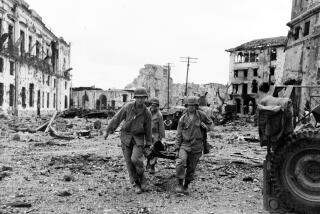See Little Hope for an Earl Recovery : Philippines Locked in Worst Economic Crisis
- Share via
MANILA — Buried in a $25.6-billion foreign debt and borrowing billions more, the Philippines is locked in its worst postwar economic crisis with little hope of an early recovery.
Despite a long-awaited loan and trade credit agreement, financial experts say sustained recovery depends more on whether President Ferdinand Marcos can implement reforms in the economy and lure back wary investors.
The agreement, signed May 20 with a 12-bank advisory committee representing 483 foreign banks, forms a critical component of a $10-billion economic recovery package.
Fresh Loans
It encompasses $925 million in fresh loans--half of what the government sought when it began negotiations last year--and $3 billion in trade credit facilities that were suspended for 20 months.
Prime Minister Cesar Virata believes that the entire program may be in place by October.
But financial analysts, bankers and businessmen say the Philippines has a long way to go before it can recover from the tailspin generated by the Aug. 21, 1983, assassination of Marcos’s archrival, opposition leader Benigno Aquino.
“It does give the Philippines substantial breathing space to put its house in order,” a Manila-based American banker said. “But the only thing that’s going to benefit the Philippines in the long run is a return of confidence.
“The confidence level during this whole period has dropped to near zero.”
Marcos, who has ruled the Philippines since 1965 and who plans to seek reelection, said after the signing that he was confident that the Philippines would recover “faster than we may envision right now.”
He has pledged to reform the agricultural sector, reorganize government financial institutions, lift price controls and dismantle many of the 315 government-owned or controlled corporations.
“There’s a feeling a lot of the right things are being said but we’ll have to wait and see if the administration of these acts is fruitful,” American businessman Lewis Burridge said.
“If we can handle the political issues we should be on the right track,” said Jose Concepcion, president of Republic Flour Mills.
Murder Triggered Scare
In October, 1983, as a political scare triggered by the Aquino murder resulted in a flight of capital, the swift decline in foreign currency reserves prompted the government to declare a moratorium on principal payments on its external debts.
The new money will be used in part to make payments on interest on the outstanding loans.
The billion in trade credits, roughly equal to the amount outstanding when they also were suspended in 1983, will be used to restore the financing of Philippine trade, central bank officials said.
A final phase involves the rescheduling of the principals on $5.86 billion in loans due from October, 1983, to December, 1986. Another rescheduling is expected in 1987.
Rounding out the package is $2.1 billion in loans from governments and multilateral agencies through the Paris Club and a $610-million facility from the International Monetary Fund.
How fast the new $925 million flows and how much will be left after interest payments will largely depend on whether the country can meet tough targets set by the IMF in exchange for its approval of the program.
Under the agreement, the money will be released in three drawdowns, once the IMF has reviewed Manila’s compliance with the targets, including reserve money levels, the peso-dollar exchange rate and import and export levels.
Worry About Sincerity
Beyond worries over labor unrest, a growing communist insurgency and Marcos’ sincerity in implementing the reforms, businessmen fear potentially devastating economic effects of local elections in 1986 and presidential polls in 1987.
Reserve money levels soared during the ruling party’s spending spree during the May, 1984, parliamentary polls.
Coupled with massive bail-outs for distressed banks, the surge in reserve money levels forced central bank officials to maintain an investment-stifling policy of high interest rates--which made treasury notes and other bills more attractive than plant expansion.
Export targets may also be difficult to achieve, with a slump in the semiconductor industry, coconut exports lagging, unprecedented low sugar prices and stiff foreign competition in textiles.
A new central bank report says exports dropped by 9.4% in the first quarter of 1985, despite forecasts of a 10% increase.
Virata and central bank Governor Jose Fernandez, Marcos’s principal economic architects, are nonetheless optimistic that the economy will perform better than in 1984, when the country registered negative growth for the first time since its postwar independence.
The country of 55 million also suffered inflation as high as 65%. And, amid hopes of boosting exports, the value of the local currency fell at the IMF’s behest from 7 pesos to the dollar in mid-1983 to 18.50 to the dollar today.
Expects Slight Growth
Virata said the government expects a slight growth in the economy this year, inflation of 10% to 15%, a trade surplus and lower interest rates of 20% to 22% from a high of nearly 40%.
The independent Center for Research and Communication is less encouraging.
CRC analysts predict a second year of negative growth at about 1%, 29% interest rates, 24% inflation, a peso-dollar rate of 21 to 1, a 5% drop in exports over 1984 and a slight trade deficit.
Against Marcos’s estimate of recovery in two years, CRC says five years is a better bet.
Arthur Aguilar, president of PCI Management Consultants, a specialist in receiverships, predicted a smaller economy in 1987 than that in 1983.
“If we don’t borrow any more starting today, we’d still have one of the highest debt-ratio burdens in the world,” Aguilar said. “But you and I know we can’t operate without more dollars, so we borrow more. We’re digging ourselves deeper into the hole.”
More to Read
Sign up for Essential California
The most important California stories and recommendations in your inbox every morning.
You may occasionally receive promotional content from the Los Angeles Times.












